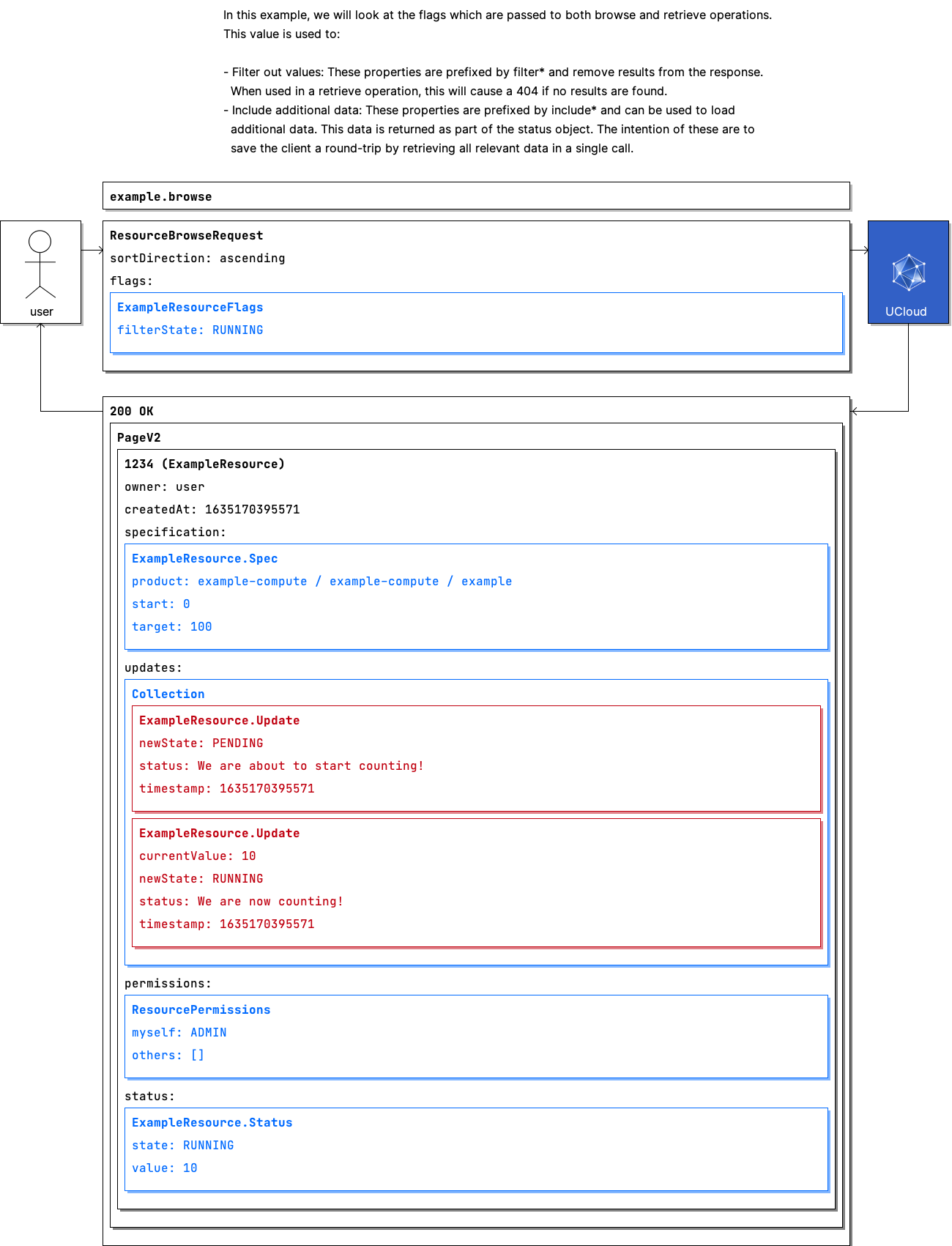Example: Browsing the catalog with a filter¶
| Frequency of use | Common |
|---|---|
| Actors |
|
Communication Flow: Kotlin
/* In this example, we will look at the flags which are passed to both browse and retrieve operations.
This value is used to:
- Filter out values: These properties are prefixed by filter* and remove results from the response.
When used in a retrieve operation, this will cause a 404 if no results are found.
- Include additional data: These properties are prefixed by include* and can be used to load
additional data. This data is returned as part of the status object. The intention of these are to
save the client a round-trip by retrieving all relevant data in a single call. */
Resources.browse.call(
ResourceBrowseRequest(
consistency = null,
flags = ExampleResourceFlags(
filterCreatedAfter = null,
filterCreatedBefore = null,
filterCreatedBy = null,
filterIds = null,
filterProductCategory = null,
filterProductId = null,
filterProvider = null,
filterProviderIds = null,
filterState = State.RUNNING,
hideProductCategory = null,
hideProductId = null,
hideProvider = null,
includeOthers = false,
includeProduct = false,
includeSupport = false,
includeUpdates = false,
),
itemsPerPage = null,
itemsToSkip = null,
next = null,
sortBy = null,
sortDirection = null,
),
user
).orThrow()
/*
PageV2(
items = listOf(ExampleResource(
createdAt = 1635170395571,
id = "1234",
owner = ResourceOwner(
createdBy = "user",
project = null,
),
permissions = ResourcePermissions(
myself = listOf(Permission.ADMIN),
others = emptyList(),
),
specification = ExampleResource.Spec(
product = ProductReference(
category = "example-compute",
id = "example-compute",
provider = "example",
),
start = 0,
target = 100,
),
status = ExampleResource.Status(
resolvedProduct = null,
resolvedSupport = null,
state = State.RUNNING,
value = 10,
),
updates = listOf(ExampleResource.Update(
currentValue = null,
newState = State.PENDING,
status = "We are about to start counting!",
timestamp = 1635170395571,
), ExampleResource.Update(
currentValue = 10,
newState = State.RUNNING,
status = "We are now counting!",
timestamp = 1635170395571,
)),
providerGeneratedId = "1234",
)),
itemsPerPage = 50,
next = null,
)
*/
Communication Flow: Curl
# ------------------------------------------------------------------------------------------------------
# $host is the UCloud instance to contact. Example: 'http://localhost:8080' or 'https://cloud.sdu.dk'
# $accessToken is a valid access-token issued by UCloud
# ------------------------------------------------------------------------------------------------------
# In this example, we will look at the flags which are passed to both browse and retrieve operations.
# This value is used to:
#
# - Filter out values: These properties are prefixed by filter* and remove results from the response.
# When used in a retrieve operation, this will cause a 404 if no results are found.
# - Include additional data: These properties are prefixed by include* and can be used to load
# additional data. This data is returned as part of the status object. The intention of these are to
# save the client a round-trip by retrieving all relevant data in a single call.
# Authenticated as user
curl -XGET -H "Authorization: Bearer $accessToken" "$host/api/example/browse?filterState=RUNNING&includeOthers=false&includeUpdates=false&includeSupport=false&includeProduct=false"
# {
# "itemsPerPage": 50,
# "items": [
# {
# "id": "1234",
# "specification": {
# "start": 0,
# "target": 100,
# "product": {
# "id": "example-compute",
# "category": "example-compute",
# "provider": "example"
# }
# },
# "createdAt": 1635170395571,
# "status": {
# "state": "RUNNING",
# "value": 10,
# "resolvedSupport": null,
# "resolvedProduct": null
# },
# "updates": [
# {
# "timestamp": 1635170395571,
# "status": "We are about to start counting!",
# "newState": "PENDING",
# "currentValue": null
# },
# {
# "timestamp": 1635170395571,
# "status": "We are now counting!",
# "newState": "RUNNING",
# "currentValue": 10
# }
# ],
# "owner": {
# "createdBy": "user",
# "project": null
# },
# "permissions": {
# "myself": [
# "ADMIN"
# ],
# "others": [
# ]
# }
# }
# ],
# "next": null
# }
Communication Flow: Visual
